
Atlas F1 Technical Writer
The German Grand Prix saw quite a few teams introduce new changes on their cars - from minimal solutions to a complete chassis overhaul. Atlas F1's Craig Scarborough takes a look at the technical changes throughout the weekend, and he analyses their effect on the cars
The smooth track surface and hotter temperatures create problems for the tyre manufacturers, tyres slide more and soon overheat, which leads to blisters. Equally the tight nature of many of the curves, often preceded by short straights, places huge strain on the brakes; this lack of grip and heavy braking also lends itself to driver errors and leads to opportunities for overtaking, as proven during the race.
Additionally the lack of grip and tyre issues steer the teams away from two stop strategies, as the tyre degradation and traction issues with a heavy fuel load make it slower.
BAR Banned Front Brake Device
BAR were banned from running a development front brake set up during Friday practice. In a reworking of Benetton's FTT systems used in 1999, BAR linked the front wheels with drive shafts and coupled them to an electronic clutch. Its appearance was a surprise as the system was allowed in 1999, but has since been clarified by the rules to ensure it was not re-introduced. Earlier BAR had boasted of several radical developments in the pipeline, one of which was in the front suspension design.
If torque from the heavily loaded outer wheel could be transferred to the inner wheel, this would stop the inner wheel locking up, preserving the tyre and slowing the car more effectively. Additionally, the clutch could be engaged to brake a single wheel out of corners, as an active steering device to control slides. All of the possibilities the system offers for dynamically controlling the chassis make it ripe for banning under the driver aid regulations.
Each of the drivers tried the system, both in testing at Jerez and in the Friday practices, and from the team's comments after Friday it appears it was planned to run the system all weekend. By Friday evening a statement from FIA technical delegate Jo Bauer had deemed the system outside of the technical regulations (article 11.1.3) and BAR were forced to withdraw the system.
Team by Team
Ferrari
After a season of few technical changes the team arrived in Germany with a new front wing. Adopting only two profiles over the usual three, the wing now features a pronounced dip in the centre, placing the wing closer to the ground and potentially making more downforce, for an increase in pitch sensitivity. The trailing edge of the wing formed a new shape with aggressive changes in the curves, and creating more wing area in the outer sections of the wing. Overall the wing should provide more downforce at the cost of drag, so could be expected to appear in Hungary but not the faster circuits thereafter.
This could not be proven as in the race he made a misjudged manoeuvre on David Coulthard, who himself had made an error under braking. In the mêlée he lost his front wing and pitted immediately for a new one, topping up on fuel for a long afternoon on two stops. As is the usual case the luck went to Schumacher, who had only a slow first pit stop as a delay on the way to victory.
Williams
After the bodywork revisions Williams have run to date a new chimney has also taken its design from another team on the grid. This time it's from Ferrari, as the new chimney slants outwards and exits from the side rather through the top. The larger chimney was not needed in Germany, so the team ran the exit closed off to maintain engine temperatures.
At the race's second start Montoya's clutch didn't bite at the expected point and he lost fives places, after which his race soon degenerated with blistering rear tyres which saw him slide off the road on several occasions. However, both cars were able to last the race to post two points finishes, albeit far behind the potential shown earlier in the weekend.
McLaren
The team resurgence at Silverstone with the B spec car has not stopped as the team tested a new nose cone and front wing in testing following the British race. The new wide nosecone works in conjunction with a front wing span which is flatter across its centre, rather than the curved wing introduced earlier this season.
While Kimi Raikkonen was happy with the car on Friday, Coulthard was less so after two scary spins under braking. For qualifying Coulthard was more settled and set a time just behind his team mate, the team being confident of their pace with the level of fuel on board. At the races false start McLaren had the first mechanics on the grid with cooing fans, showing the team are both well prepared and still have cooling issues.
Raikkonen made a good start and soon passed Fernando Alonso for second; he was then able to keep pace with Schumacher, but unable to make his later first pit stop work in his favour. Only two laps after his pit stop his rear wing failed, the main plane collapsing and taking the rear flap with it, leaving the endplates intact. His car spun at high speed and went off into the tyre barriers, Raikkonen emerged upset but unhurt. The team were sure the problem was a one-off manufacturing fault, but checked Coulthard's car carefully at his next stop.
On Lap1 Coulthard had an incident with Barrichello, and later lost part of his bargeboard after hitting the debris from his team mate's crash; as a result he was starting to struggle with understeer. His wasn't able to compete in the last laps, and finished a creditable fourth.
Renault
After recent major aero updates and the Silverstone suspension failure, Renault arrived in Germany with a reinforced rear suspension and a revised front wing. Engine wise Germany saw the next big step in the R24's development, with new internals in the bottom end of the engine and revision to the timing gears following the failure in Britain.
A clean run in both Friday and Saturday sessions only saw the team comment on handling from oversteer to understeer as conditions changed. Conversely the race saw incident for both drivers, after blinding starts for both cars even saw Alonso challenge for the lead into the first corner.
Alonso had part of his bargeboard trapped under the car, affecting his handling quite considerably - this was ejected from under the car when he rode over a kerb, and he was again able to run at his expected pace. Jarno Trulli had part of Raikkonen's rear wing trapped under his front wing later in the race; this was cured when he pitted on Lap 28, but he had run too long with the obstruction and compromised his race.
One curious situation during the race was Buttons inability to out-drag Alonso out of the hairpins - several times Alonso out braked himself into the turn, allowing Button to run up the inside get on the power earlier and carry more momentum through the turn. While Button may have had more fuel on board, offset by slightly fresher tyres than Alonso, he was never able to beat Alonso to the next turn.
This suggests that the Renault traction, especially out of a slower corner, is superior to other teams, a fact also demonstrated at the start of the races. It is suggested that the power delivery characteristics of the Renault make amends for its lack of outright power, whether Renault retain this traction as its power output matches its rivals will be interesting.
BAR
Unnoticed in this column BAR ran dramatically different bodywork on Friday at Silverstone, with a rounded flip up ahead of the chimney/winglet set up. There was also a Jaguar style vertical flap holding up the main flip up - this was discarded due to its sensitivity to the strong winds in Britain, and not present in Germany.
Controversially, the torque transfer system was tried on Friday until banned by the FIA. The system comprised revised uprights that linked the stub axles to driveshaft via a small CV joint, visible inside the brake duct. The brake ducts were correspondingly larger on the TTS equipped cars, to account for the small blockage created by the driveshaft. The shafts linked to a small electro hydraulic clutch, mounted above the keel and powered by the feed to the power steering. All these mechanicals were hidden by a carbon fibre cover.
Honda brought a revised spec engine to Germany, while the team had prepared high temperature spec cooling bodywork and had made revision to the carbon fibre gearbox following problem spotted during testing. Even before the FIA instruction Friday was already creating problems for the team – Jenson Button had an engine problem that would eventually require a replacement, costing him ten grid places, and Anthony Davidson has gearbox problems, leaving only Takuma Sato with a trouble free day.
These problems were tempered with knowledge that the car was running strongly at the circuit, which no doubt made the FIA's decision easier. It was Sato's day for problems on Saturday, losing the morning session and correspondingly hindering his qualifying runs. Button, with a looming ten place penalty, put in a lap fast enough for third and left the other teams wondering about his fuel strategy for the race.
In the race good starts saw the cars make up some ground, and it was Sato to pit first on Lap 10. The surprise was then Button did not pit until Lap 14; the extra four laps of fuel must have hindered his qualifying run and race pace, but such was the cars speed this weekend he was able to cope and regain many positions while he stayed out these laps.
Sauber
One of the few teams with little visible development, but seeing as the team still understood the new Silverstone spec bodywork, this was not surprising. After a positive Silverstone race, the team were prepared to play a long strategy and qualified on a heavy two stop fuel in order to make the most of the Bridgestone's expected advantage in the race. This wasn't to be, as the both drivers struggled; Felipe Massa finding his tyres blistering and Giancarlo Fisichella having a stubborn rear wheel that refused to come off in his second stop, forcing him to complete the race on the old tyre.
Jaguar
Despite the clever new brake ducts the team found problems with the installation on the Christian Klein and Bjorn Wirdheim cars, so were forced to change them on all three cars. The team caught up the lost time, and the balance of Friday and Saturday went cleanly. In the race Mark Webber made a good start and some well judged passes on the first lap to get up to sixth, he was then able to hold this position to the end of the race. Klien enjoyed a good race to finish back in tenth.
Toyota
Sidepods also came in for revisions, with a Renault-like chimney replacing the grills and a mid wing added to the engine cover, underneath which is a new spec engine pushed into its debut three races early. If the results appear similar to Renault, then it is no surprise as all of these developments were overseen by Mike Gascoyne, who oversaw the chassis work and directly lead the aero team.
In the race a repeat of previous problems saw Olivier Panis stall on the grid, forcing a delayed start. He had to start from the back of the grid, and conceded a possible points finish as a result. Cristiano da Matta suffered a rear tyre failure on Lap 41, having felt a vibration building for several laps.
Jordan
The small control strip mounted to the flank of the sidepods suggest the latter might be more likely. The shoulder wings are allowed under the flat bottom rules as they are shadowed by the fins (often called water wings) at floor level in front of the sidepods. I doubt these are a major new design direction for other teams, as they are probably a cure for a problem than a pure performance enhancing part.
Minardi
As is usual Minardi appeared with familiar cars unchanged from usual configuration. Friday saw a mix of handling and minor technical problems, which improved for qualifying. In the race troubles focussed on Gianmaria Bruni's car that was overfull of oil, and later had a loose bargeboard costing him time in the pits. But the two cars did make it to the finish, and only twenty seconds apart.
For Round 12 the teams arrived at Hockenheim fresh from a week's break and/or some testing after a string of back-to-back races. This, and the low speed nature of the next two races, saw a huge raft of new parts from nearly every team on the grid. The Hockenheimring is no longer the autobahn style circuit of the eighties and nineties - the loop into the forests has been replaced with a tighter circuit set in front of the concrete grandstands, and these revisions put the track amongst the higher downforce tracks, rather than the super low downforce set up from before.
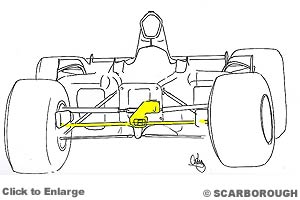 In essence the system interconnects the front wheels with an adjustable clutch, which can vary the torque transferred from one wheel to another. This torque transfer can be varied by the car's control software to complete some clever tricks. In a corner the inside wheel travels slower and is lightly loaded so is prone to locking up, while the outer wheel is making the maximum use of its brake.
In essence the system interconnects the front wheels with an adjustable clutch, which can vary the torque transferred from one wheel to another. This torque transfer can be varied by the car's control software to complete some clever tricks. In a corner the inside wheel travels slower and is lightly loaded so is prone to locking up, while the outer wheel is making the maximum use of its brake.
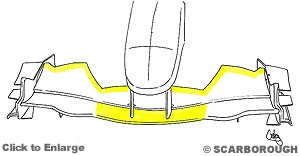 Friday went cleanly for Michael Schumacher, while Rubens Barrichello struggled with balance and minor technical gremlins. Qualifying went along similar lines, with Schumacher finding previously unfound speed in the 3rd sector to post pole position, while Barrichello was much further back, leading to the belief he a lot more fuel on board.
Friday went cleanly for Michael Schumacher, while Rubens Barrichello struggled with balance and minor technical gremlins. Qualifying went along similar lines, with Schumacher finding previously unfound speed in the 3rd sector to post pole position, while Barrichello was much further back, leading to the belief he a lot more fuel on board.
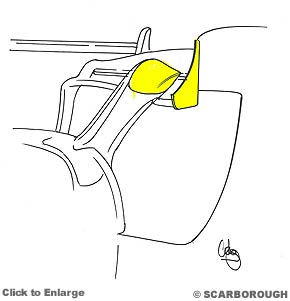 Friday was an encouraging start to the weekend, with new race driver Antonio Pizzonia close to Juan Pablo Montoya on the time sheets. The latter's performance carried over into qualifying, with only Montoya's slow third sector keeping him off pole, while Pizzonia and the team were openly disappointed with his time, which was compromised by a set up change after Q1.
Friday was an encouraging start to the weekend, with new race driver Antonio Pizzonia close to Juan Pablo Montoya on the time sheets. The latter's performance carried over into qualifying, with only Montoya's slow third sector keeping him off pole, while Pizzonia and the team were openly disappointed with his time, which was compromised by a set up change after Q1.
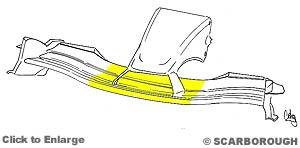 This set up replaced the needle nose introduced with the MP4-18 and subsequent 19, which needed to droop down to meet the W format wing, allowing the airflow to split either side of the nose rather than passing under or over it. This Nose/wing combination was not adopted in Germany, as wet weather in testing prevented the team making meaningful comparisons.
This set up replaced the needle nose introduced with the MP4-18 and subsequent 19, which needed to droop down to meet the W format wing, allowing the airflow to split either side of the nose rather than passing under or over it. This Nose/wing combination was not adopted in Germany, as wet weather in testing prevented the team making meaningful comparisons.
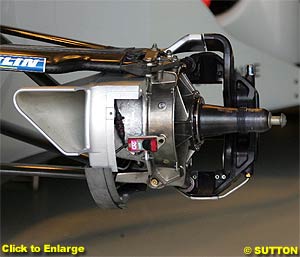 Two small developments were noticed on the car - the mid wing mounted to the engine cover and revised brake ducts. While the unusual silver finish on the outer duct may only have been a heat reflective finish, the small duct that routed around the disc and fed the outer calliper pistons was new, and an approach not seen before. Most teams route air through the centre of the disc to blow air onto the pistons, or have a duct around the back of the calliper to blow through the back of the calliper onto the pistons.
Two small developments were noticed on the car - the mid wing mounted to the engine cover and revised brake ducts. While the unusual silver finish on the outer duct may only have been a heat reflective finish, the small duct that routed around the disc and fed the outer calliper pistons was new, and an approach not seen before. Most teams route air through the centre of the disc to blow air onto the pistons, or have a duct around the back of the calliper to blow through the back of the calliper onto the pistons.
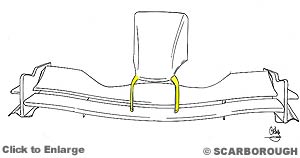 If not visibly, Toyota had the most changed car on the grid at Hockenheim. The B spec of the TF103 debuted with a new chassis, which is both lighter and allows a lower centre of gravity by the addition of more low-placed ballast. The aerodynamics were revised with a new nosecone and front wing, which was slimmer and spaced the drop plates away from the nose. The wing itself curves across more of its span, unlike the old wing that had a more pronounced dip in the very middle of the wing.
If not visibly, Toyota had the most changed car on the grid at Hockenheim. The B spec of the TF103 debuted with a new chassis, which is both lighter and allows a lower centre of gravity by the addition of more low-placed ballast. The aerodynamics were revised with a new nosecone and front wing, which was slimmer and spaced the drop plates away from the nose. The wing itself curves across more of its span, unlike the old wing that had a more pronounced dip in the very middle of the wing.
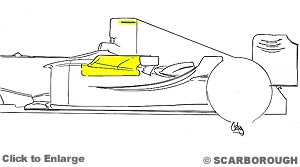 Having not run the car in its full B spec configuration, the team spent Friday split between proving the new cars aero components and the usual tyre evaluation work. Not surprisingly the drivers struggled to get a good set up, and these compromises ran through into the qualifying sessions.
Having not run the car in its full B spec configuration, the team spent Friday split between proving the new cars aero components and the usual tyre evaluation work. Not surprisingly the drivers struggled to get a good set up, and these compromises ran through into the qualifying sessions.
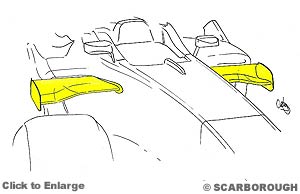 While Jordan have been criticised for being conservative in their design this year, they have now run probably the most outlandish aerodynamic device for any team in years - during Friday testing Timo Glock ran a car with winglets in front of the shoulders of the sidepods. These curved shoulder wings form a steep aerofoil section on their outer ends – this, mixed with the endplate, would send a vortex along the top edge of the sidepod, which could either interact with the chimney/winglet, or pass under the flip up.
While Jordan have been criticised for being conservative in their design this year, they have now run probably the most outlandish aerodynamic device for any team in years - during Friday testing Timo Glock ran a car with winglets in front of the shoulders of the sidepods. These curved shoulder wings form a steep aerofoil section on their outer ends – this, mixed with the endplate, would send a vortex along the top edge of the sidepod, which could either interact with the chimney/winglet, or pass under the flip up.
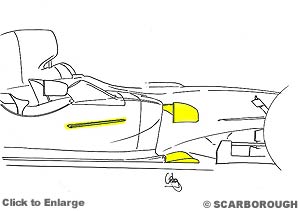 A tough weekend unfolded for the team; brake locking problems blighted Friday's session, as well as Glock breaking two front wings and suffering an engine software problem. Saturday saw the pressure on as a clutch problem was detected in Nick Heidfeld's car, and Giorgio Pantano went off in morning practice. In the race a puncture cost Pantano a huge amount of time as he recovered to the pits, plus Heidfeld suffered a worsening handling problem - at first thought to be a puncture then suspension failure, eventually he saw the car retire as the problem could not be satisfactorily identified.
A tough weekend unfolded for the team; brake locking problems blighted Friday's session, as well as Glock breaking two front wings and suffering an engine software problem. Saturday saw the pressure on as a clutch problem was detected in Nick Heidfeld's car, and Giorgio Pantano went off in morning practice. In the race a puncture cost Pantano a huge amount of time as he recovered to the pits, plus Heidfeld suffered a worsening handling problem - at first thought to be a puncture then suspension failure, eventually he saw the car retire as the problem could not be satisfactorily identified.
|
Contact the Author Contact the Editor |
Please Contact Us for permission to republish this or any other material from Atlas F1.
|
Volume 10, Issue 30
Atlas F1 Exclusive
Interview with John Iley
Bjorn Wirdheim: Going Places
Ann Bradshaw: Point of View
2004 German GP Review
2004 German GP Review
Technical Review: Germany 2004
Raising the BAR (Part III)
A Wing and a Prayer
Stats Center
Qualifying Differentials
SuperStats
Charts Center
Columns
The F1 Insider
Season Strokes
On the Road
Elsewhere in Racing
> Homepage |